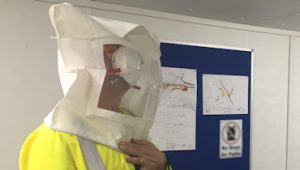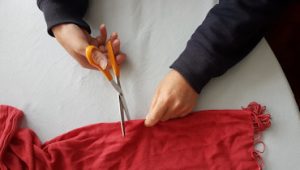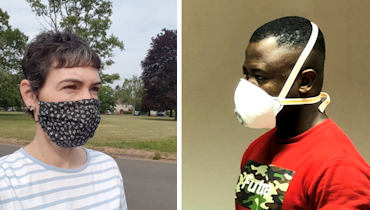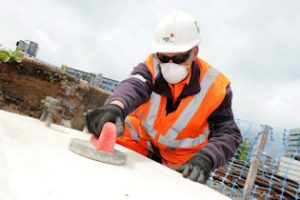Different types of mask have different purposes
Wear the correct mask for the task.
- Dust masks for work are provided as part of your work PPE to stop you breathing in dust.
- A fabric face covering will help stop you passing on coronavirus germs to other people.

Dust masks
If your work means you need a face mask, please follow the manufacturer’s instructions for wearing it correctly.
A correctly fitted dust mask will protect you from breathing in dust and particles, which can damage your lungs, leading to illnesses including silicosis. There is no cure for silicosis. It can be fatal, and it is also linked to COPD, heart failure and cancer.
You must have training on how to wear a dust mask, including face-fit testing and a toolbox talk.
Cloth face coverings
Unless you are exempt, you must wear a fabric face covering on public transport, and in most other public indoor places. You should also wear a face covering if you need to be closer than 2m to someone else. See the Public Health England website for more information.
Your mask should cover your nose and mouth.
It is straightforward to make a cloth face mask from two layers of cloth, such as a pillowcase, T-shirt or bandana. You will need enough material to cover your nose and mouth.

There are instructions on the Public Health England website, and also on the BBC website, or you can find videos on YouTube.
If you wear glasses or a hearing aid, you may find tying your mask behind your head more convenient than elastic over your ears.
Care when handling your mask or face covering:
- Wash your hands thoroughly before you put your mask on, and after you take it off.
- Handle it by the fastenings – don’t touch the front.
- If you accidentally touch the front of your mask, clean your hands.
- Lean forward as you take it off, holding it just by the fastenings, so it falls off forwards, and you don’t have to pull at it.
After you have worn a fabric mask once, wash it. Fabric face masks can go in with your other laundry, using your normal detergent.
How do fabric face masks help limit the spread of coronavirus?
The virus is in droplets in the air you breathe, sneeze or cough out.
The droplets are too heavy to travel far – most of them can only travel around a metre. That is why we keep 2m apart wherever possible.
Gravity makes the droplets fall down on to surfaces. If you touch a surface which has coronavirus droplets, and then touch your eyes, nose or mouth, you will ingest the droplets.
That’s why we are all asked:
- to wash our hands often
- to avoid touching eyes, nose and mouth
- to stay 2m away from other people
Your fabric face covering will help to stop your droplets reaching other people if you are in an enclosed space where you can’t stay 2m apart. If everyone wears one, together we will slow the spread of coronavirus.
These are not the same as the surgical masks or respirators which healthcare workers wear to protect themselves when treating patients with COVID-19.
A face covering does not replace other ways to protect yourself from coronavirus:
- Keep to a social distance of at least two metres (six feet) wherever possible.
- Wash your hands regularly for at least 20 seconds.
- If you have coronavirus symptoms such as a high temperature, a change to your sense of taste or smell, or a new continuous cough, isolate at home for at least seven days – or until you have a negative test result.


